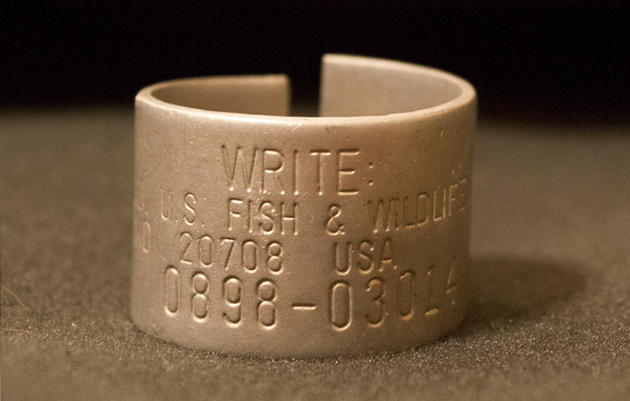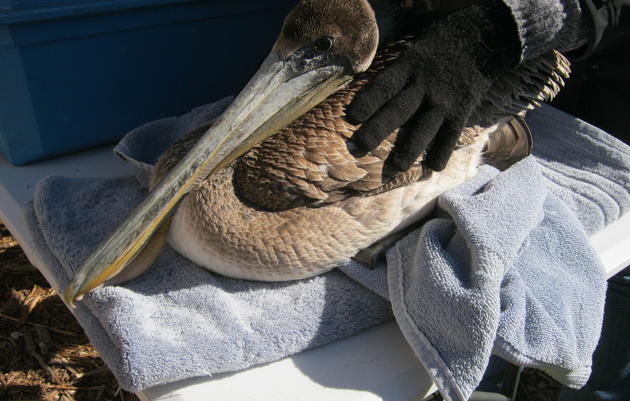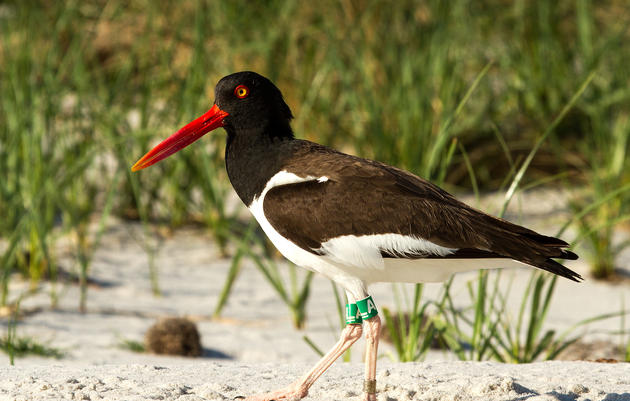While most of North Carolina’s Brown Pelicans migrate south, some remain in the state throughout the winter and are joined by some that nest in Virginia and Maryland.
Most of the time, winters on the coast are mild, compared to temperatures in the mountains and farther north up the Atlantic seaboard. And, if you stay, you might be first in line to secure the best nesting site when spring finally comes, or you might just avoid the dangers of migration and the challenges of learning your way around new wintering habitat. However, coastal North Carolina does experience freezing temperatures and even snow and ice storms.
So what happens to pelicans when it freezes?
The best thing a pelican can do when winter weather strikes is undertake a late migration. In most years, Audubon staff see a drop in the size of flocks between late fall and winter.
In December 2017, for example, over 2,000 pelicans were roosting on the Cape Fear River, enjoying mild temperatures. Following the winter storm in the first week of January, only a few hundred remained. Most of the original 2,000 likely migrated south: those that remained faced many dangers, which wild bird rehabilitators know very well.
We spoke with two who often receive pelicans from Audubon islands on the Cape Fear River: Skywatch Bird Rescue, based near Wilmington and operated by Amelia Mason, and Sea Biscuit Wildlife Shelter, located on Oak Island and operated by Mary Ellen Rogers, are licensed facilities that specialize in bird rehab. Following the snow storm in early 2018 and continuing sub-freezing temperatures, they—with the help of many volunteers—took in dozens of Brown Pelicans, and other birds affected by the cold.
The first challenge the pelicans face is surviving the frigid days and nights. If they are already undernourished, they may not have enough calories to maintain their body temperature (usually around 103-106 F) and can become hypothermic and die. “The recent cold snap has brought in not only pelicans but Killdeer, Woodcocks, Ruddy Ducks and other migrants,” says Mary Ellen. “They appear to be cold but okay, when in reality they have lost half their body weight just trying to keep warm. Most died within 24 hours. We even had a Wood Stork with a body temperature of 59.4 degrees. He died despite our best efforts.”
Amelia explains that the most common misconception about hypothermia is that birds only need to be warmed up to recover: “When a bird has hypothermia, you cannot tell just by looking since there is no obvious sign of injury, other than the bird is grounded. So people often try to feed them and provide care themselves, not understanding the urgency of the need for proper medical attention."
Rehabbers provide slow incubation, fluids and electrolytes, painkillers, antibiotics, and food and rest. They also know what a bird should weigh and can evaluate when it’s strong enough to survive in the wild. Therefore, they advise, even if a bird has no apparent injury or seems to revive, it should be brought to a licensed wildlife rehabilitator right away.

In addition to hypothermia, pelicans also face the special danger of frostbite to their pouches and webbed feet. Mary Ellen says individuals that stay in the water are better off because it’s warmer than the air. However, many still suffer frostbite. “Frostbite is a painful condition that kills cells so pelicans can lose feet and other parts of their extremities,” explains Amelia. Necrotic (dead) tissue can’t grow back and therefore frostbite can leave holes in webbed feet and pouches. “Unfortunately, the damage cannot be reversed. All you can do is wait, assess the extent of it, and treat it medically if it’s not too severe.”
“The public doesn't see the damage done,” Mary Ellen says. “They just notice the strange behavior of cold pelicans. When they arrive here at the Sea Biscuit, they have cold, swollen pouches and pink, puffy webbing on their feet. It takes 3-8 days to get a handle on the damage done as the necrosis becomes obvious. Topical oils and ointments don't work. Our treatment is mainly focused on keeping fecal matter and rough flooring from making things worse. Sometimes they even have frozen eyelids!”
Both Amelia and Mary Ellen sought advice from other experienced rehabbers when they began working with pelicans so they could provide standardized treatment. “Food, warmth, cleanliness, and painkillers are administered if indicated for two weeks,” says Mary Ellen. “Then if the pouch has dime-sized lesions or webbing damage is less than 10%, they are held until danger of frost is over or until they can be transported to Georgia for release. If there are large tears in the pouch or exposed bones in the feet, they are euthanized.” Though this is sad, these conditions would prevent the pelicans from surviving in the wild and lead to additional suffering.
What can people do to help pelicans or any other bird that can’t fly or seems otherwise “not right” during the cold?
“Survival of cold-related trauma is extremely time-sensitive,” says Amelia. “When you find a bird after a cold snap, immediately wrap it in a towel and bring it indoors so it can slowly warm up. Do not try to feed it or give it water. Simply the stress of being handled can kill it in that fragile phase, so keep it in a confined warm, dark, and quiet place. Once the bird is secured safely, call a license wildlife rehabber and arrange transport to the facility.” Since Amelia and Mary Ellen are entirely funded by donations and staffed by volunteers, assisting with transportation is highly valuable as well.
If you aren’t already familiar with your local wildlife rehabber (Amelia and Mary Ellen are just two of many around the state), you can look up licensed rehabbers in North Carolina here. If you want to help further, you can consider volunteering or donating to a wildlife rehabilitator.
See Part I of this series on wintering Brown Pelicans to learn more about what happens to pelicans in the winter!









